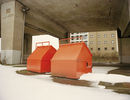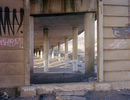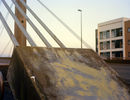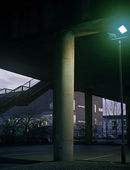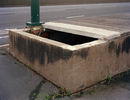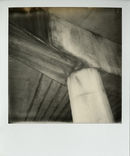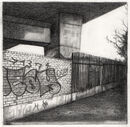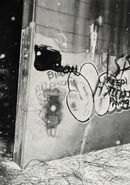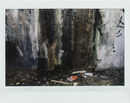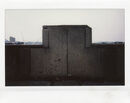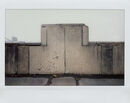II*
2018 - 2019
"The concrete junction of the two motorway routes shone in the sunlight like an elegant sculpture."
-J.G.Ballard, Concrete Island
In this exhibition, the Newport-based artist James Milne gives us his responses to the infrastructure of South Wales – some of it post-industrial, some of it post-War. In particular, the exhibition focusses on Newport’s George Street Bridge, a concrete structure spanning the River Usk constructed in the 1960s. This is a significant milestone in the history of civil engineering as it was the first cable-stayed cantilever bridge in Britain; the same principles were used in several later structures, including the second Severn Bridge. For this reason the George Street Bridge has been given the second-highest heritage listing, Grade II*, making it one of a minority of post-War buildings in Wales with this distinction.
The period of the George Street Bridge’s construction was one of considerable faith in a future driven by material and technological progress, typified by Harold Wilson’s ‘white heat of technology’ speech of 1963. It is also the period when the architectural style known as the New Brutalism, with its unapologetic use of concrete, was at its height. Altogether, it was a time when architects and engineers, often with a strong social conscience, confidently faced the future.
Today the hopes of the ’60s have turned to prosaic reality, and at the George Street Bridge the material that once spoke of modernity and progress, concrete, now speaks of vulnerability and neglect. This fragility is at odds with the still colossal scale of the structure. In his work for this project James Milne records the graffiti-strewn piers and the mute yet expressive quality of the material.
As the heyday of Modernist construction has passed into history, its monuments have received official recognition from heritage bodies, but this is often no guarantee that they will be preserved. One of the most acclaimed works of Modernist architecture in Wales, the Brynmawr Rubber Factory, became the very first post-War building in Britain to be listed, in 1986, but despite its Grade II* listing it was demolished in 2001. The wooden cooling towers of Cwm Coke Works in Beddau, again listed at Grade II*, are in an even more precarious state, and one has collapsed entirely. This project aims to bring the vulnerable nature of these buildings to the fore.
Marc Haynes (Curator)
The II* project was exhibited at Newport Museum and Art gallery in 2019. The exhibition also included work by the following artists and photographers: Stephen Clarke, Hans Feibusch, Ron McCormick and Thomas Rathmell.
"The concrete junction of the two motorway routes shone in the sunlight like an elegant sculpture."
-J.G.Ballard, Concrete Island
In this exhibition, the Newport-based artist James Milne gives us his responses to the infrastructure of South Wales – some of it post-industrial, some of it post-War. In particular, the exhibition focusses on Newport’s George Street Bridge, a concrete structure spanning the River Usk constructed in the 1960s. This is a significant milestone in the history of civil engineering as it was the first cable-stayed cantilever bridge in Britain; the same principles were used in several later structures, including the second Severn Bridge. For this reason the George Street Bridge has been given the second-highest heritage listing, Grade II*, making it one of a minority of post-War buildings in Wales with this distinction.
The period of the George Street Bridge’s construction was one of considerable faith in a future driven by material and technological progress, typified by Harold Wilson’s ‘white heat of technology’ speech of 1963. It is also the period when the architectural style known as the New Brutalism, with its unapologetic use of concrete, was at its height. Altogether, it was a time when architects and engineers, often with a strong social conscience, confidently faced the future.
Today the hopes of the ’60s have turned to prosaic reality, and at the George Street Bridge the material that once spoke of modernity and progress, concrete, now speaks of vulnerability and neglect. This fragility is at odds with the still colossal scale of the structure. In his work for this project James Milne records the graffiti-strewn piers and the mute yet expressive quality of the material.
As the heyday of Modernist construction has passed into history, its monuments have received official recognition from heritage bodies, but this is often no guarantee that they will be preserved. One of the most acclaimed works of Modernist architecture in Wales, the Brynmawr Rubber Factory, became the very first post-War building in Britain to be listed, in 1986, but despite its Grade II* listing it was demolished in 2001. The wooden cooling towers of Cwm Coke Works in Beddau, again listed at Grade II*, are in an even more precarious state, and one has collapsed entirely. This project aims to bring the vulnerable nature of these buildings to the fore.
Marc Haynes (Curator)
The II* project was exhibited at Newport Museum and Art gallery in 2019. The exhibition also included work by the following artists and photographers: Stephen Clarke, Hans Feibusch, Ron McCormick and Thomas Rathmell.
